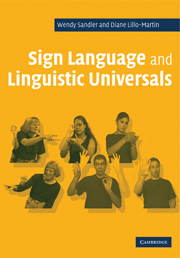Book contents
- Frontmatter
- Contents
- Preface
- Notation conventions
- UNIT I INTRODUCTION
- UNIT II MORPHOLOGY
- UNIT III PHONOLOGY
- 8 Meaningless linguistic elements and how they pattern
- 9 Sequentiality and simultaneity in sign language phonology
- 10 Hand configuration
- 11 Location: feature content and segmental status
- 12 The non-dominant hand in the sign language lexicon
- 13 Movement
- 14 Is there a syllable in sign language?
- 15 Prosody
- 16 Phonology: theoretical implications
- UNIT IV SYNTAX
- UNIT V MODALITY
- References
- Index
10 - Hand configuration
Published online by Cambridge University Press: 05 June 2012
- Frontmatter
- Contents
- Preface
- Notation conventions
- UNIT I INTRODUCTION
- UNIT II MORPHOLOGY
- UNIT III PHONOLOGY
- 8 Meaningless linguistic elements and how they pattern
- 9 Sequentiality and simultaneity in sign language phonology
- 10 Hand configuration
- 11 Location: feature content and segmental status
- 12 The non-dominant hand in the sign language lexicon
- 13 Movement
- 14 Is there a syllable in sign language?
- 15 Prosody
- 16 Phonology: theoretical implications
- UNIT IV SYNTAX
- UNIT V MODALITY
- References
- Index
Summary
Of the three major categories – hand configuration, location, and movement – the hand configuration category is the most complex. The hand has many degrees of freedom, and sign languages exploit this articulatory range, though subject to certain constraints. The four fingers and the thumb can be selected in various combinations in the articulations of handshapes. The fingers can bend at any joint, or at more than one joint at once. The thumb can be adducted or abducted, can contact fingertips, or can close over the fingers. In addition, the whole hand may be oriented in various directions. In this chapter, we present generalizations that have been discovered about the way in which these possibilities are both exploited and constrained in sign languages, and some models that have been proposed to reflect these generalizations. A chart of some common handshapes is offered in Figure 10.1 for reference.
We begin by presenting parameters along which lexical contrasts are made, each of which will later be shown to constitute a subcategory of hand configuration features. After these preliminaries, the chapter proceeds to construct a model of hand configuration that is motivated by the clustering of features in classes, both in underlying representations and in phonological processes. The overall structure of the model relies on the theory of feature geometry (e.g., Clements 1985, Sagey 1986, Halle 1992).
- Type
- Chapter
- Information
- Sign Language and Linguistic Universals , pp. 144 - 173Publisher: Cambridge University PressPrint publication year: 2006



